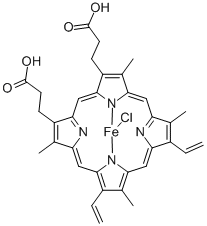
Product name:Hemin
CAS:16009-13-5
Molecular Formula:C34H32ClFeN4O4
Formula Weight:651.94
Specification:5g
Description:
The most important component of red blood cells is hemoglobin, which is a combination of globin and hemoglobin. The biosynthesis of globin is the same as that of ordinary proteins. Heme is the iron porphyrin compound, is the hemoglobin coradical, is also myoglobin, cytochrome, peroxidase, catalase and so on coradical. The heme involved in the synthesis of hemoglobin is mainly synthesized in juvenile erythrocytes and reticulocytes of bone marrow.
Each hemoglobin in the human body is composed of 4 heme (also known as ferrous protoporphyrin) and 1 globin in the middle. Each heme in turn consists of 4 pyrrole subunits forming a ring with a ferrous ion in the center. Each bead has four polypeptide chains, each of which is linked to a heme to form a monomer, or subunit, of hemoglobin. The four hemoglobin subunits in an electrolyte solution similar to the human environment can be assembled automatically into the form of alpha 2 beta 2.
Each of the four peptide chains that make up globin is different, and adults can be made up of two alpha and two beta chains, called HbA. The fetus consists of two alpha and two gamma strands, called HbF. It was replaced shortly after birth by the HbA. Hemoglobin consists of a globin and four hemoglobin, and a peptide chain of globin binds to a hemoglobin to form a subunit of hemoglobin. The four subunits bind to each other and to each other with salt bonds. The ferrous iron in the middle of each heme group can bind to oxygen to form oxyhemoglobin. Binding or dissociation with oxygen will affect the formation or fracture of salt bond, and change the quaternary structure of Hb, and its affinity with oxygen will also change accordingly. It is the basis of the s-shaped oxygen dissociation curve and Bohr effect.

